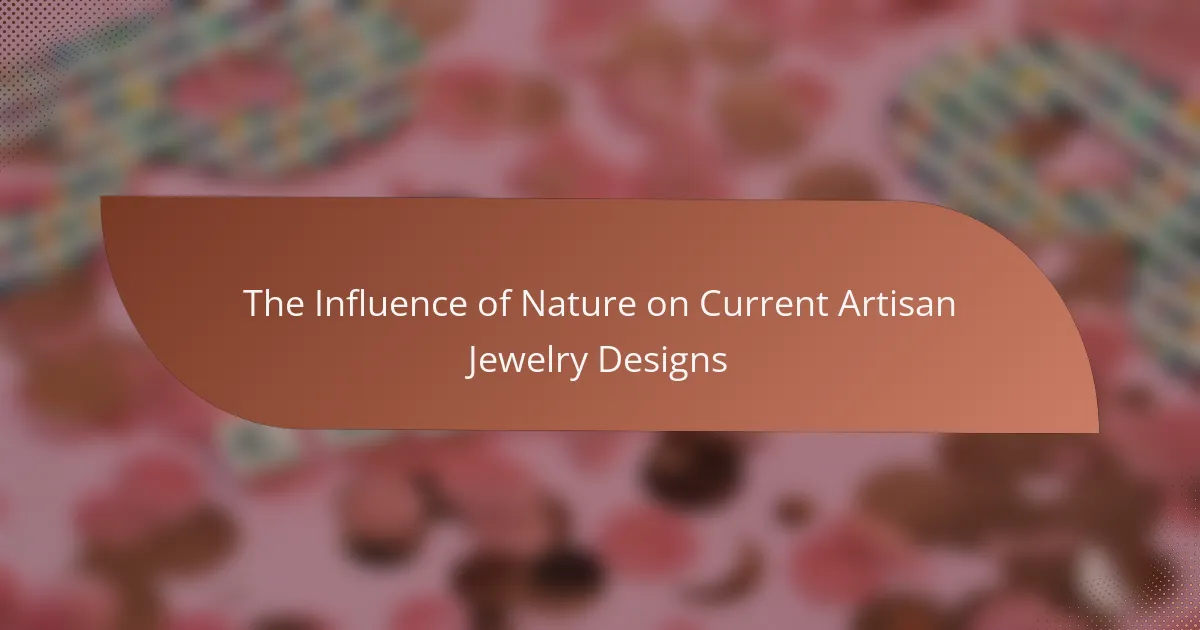The influence of nature on current artisan jewelry designs is profound, as it provides a rich source of materials, shapes, and colors that inspire creativity. Designers are increasingly drawing from the beauty of flora, fauna, and landscapes, resulting in unique pieces that embody the essence of the natural world.

How does nature inspire artisan jewelry designs in the United States?
Nature significantly influences artisan jewelry designs in the United States by providing a wealth of materials, shapes, and color inspirations. Designers often draw from the natural world to create unique pieces that reflect the beauty and diversity of their surroundings.
Use of natural materials
Artisan jewelers frequently incorporate natural materials such as gemstones, wood, and metals sourced from the environment. For example, turquoise from the southwestern U.S. or reclaimed wood from local forests can add a distinctive touch to jewelry pieces. These materials not only enhance the aesthetic appeal but also promote sustainability by reducing reliance on synthetic alternatives.
When selecting natural materials, artisans often consider their durability and how they will age over time. For instance, softer stones may require more care compared to harder gemstones, influencing their suitability for everyday wear.
Incorporation of organic shapes
Many artisan jewelry designs feature organic shapes that mimic forms found in nature, such as leaves, flowers, and waves. These shapes create a sense of fluidity and movement, making the jewelry feel more alive. For instance, a pendant shaped like a leaf can evoke the tranquility of a forest.
Artisans often use techniques like hand-forging or casting to achieve these organic forms, allowing for a personal touch in each piece. This approach not only highlights craftsmanship but also connects the wearer to the natural world.
Color palettes inspired by landscapes
Color palettes in artisan jewelry are often inspired by the diverse landscapes across the United States. Jewelers may use earthy tones like greens, browns, and blues to reflect forested areas, deserts, or coastal regions. These colors can evoke specific feelings or memories associated with nature.
When designing with color, artisans might consider the psychological effects of different hues. For example, blue can convey calmness, while earthy tones may evoke warmth and stability. This thoughtful selection enhances the emotional connection between the jewelry and its wearer.

What are popular nature-themed jewelry trends?
Popular nature-themed jewelry trends include designs that draw inspiration from flora, fauna, and natural landscapes. These trends often feature organic shapes, earthy colors, and materials that reflect the beauty of the natural world.
Floral motifs in necklaces
Floral motifs are a prominent trend in necklaces, capturing the elegance of nature’s blooms. Designs often incorporate intricate flower shapes, leaves, and vines, using materials like gold, silver, and enamel to mimic the delicate beauty of petals.
When selecting floral necklaces, consider the scale and style that best suits your wardrobe. Larger, statement pieces can serve as focal points, while smaller, subtle designs can complement everyday outfits.
Gemstone colors reflecting natural elements
Gemstones in jewelry are increasingly chosen for their colors that evoke natural elements, such as ocean blues, earthy greens, and sunset oranges. These hues not only enhance the aesthetic appeal but also resonate with the wearer’s connection to nature.
When choosing gemstones, look for stones like turquoise for oceanic vibes or moss agate for a forest-inspired look. Consider mixing different colored stones to create a vibrant, nature-inspired palette.
Animal-inspired earrings
Animal-inspired earrings are gaining popularity, showcasing designs that reflect various creatures and their habitats. From delicate butterfly studs to bold lion head earrings, these pieces celebrate wildlife and can convey personal meanings.
When selecting animal-inspired earrings, think about the symbolism behind the animal. For instance, owl earrings may represent wisdom, while dolphin designs can signify playfulness. Choose styles that resonate with your personality and values.

Which artisans are leading the nature-inspired jewelry movement?
Several artisans are at the forefront of the nature-inspired jewelry movement, creating pieces that reflect the beauty and intricacies of the natural world. Notable names include Alexis Bittar, Mejuri, and Catbird, each bringing their unique vision and craftsmanship to the designs.
Alexis Bittar
Alexis Bittar is renowned for his bold, sculptural jewelry that often draws inspiration from organic forms and natural textures. His collections frequently incorporate materials like semi-precious stones and hand-carved lucite, mimicking the fluidity and colors found in nature.
When exploring Bittar’s work, look for pieces that feature intricate floral motifs or earthy color palettes, which evoke a sense of the outdoors. His designs often blend modern aesthetics with a touch of nature, making them versatile for both casual and formal occasions.
Mejuri
Mejuri is known for its minimalist approach to jewelry, often inspired by natural elements. The brand emphasizes sustainability, using ethically sourced materials and promoting a direct-to-consumer model that reduces environmental impact.
In Mejuri’s collections, you can find delicate pieces that feature natural stones and simple designs, perfect for everyday wear. Their focus on craftsmanship and sustainability appeals to consumers looking for both style and ethical considerations in their jewelry choices.
Catbird
Catbird specializes in handcrafted jewelry that highlights the beauty of nature through unique designs and ethical practices. Based in Brooklyn, New York, Catbird uses recycled materials and conflict-free stones, ensuring that their pieces are both beautiful and responsible.
Look for Catbird’s whimsical designs, which often include floral and animal motifs, capturing the essence of nature in a charming way. Their commitment to sustainability and local craftsmanship resonates with customers who value both artistry and environmental responsibility.

How to choose nature-inspired jewelry for personal style?
Choosing nature-inspired jewelry involves aligning the pieces with your personal style, wardrobe, and the occasions you attend. Focus on designs that resonate with your aesthetic preferences while ensuring they complement your overall look.
Consider personal aesthetics
Your personal aesthetics play a crucial role in selecting nature-inspired jewelry. Think about the styles you are drawn to, whether they are minimalist, bohemian, or vintage. For instance, if you prefer a bohemian look, consider pieces featuring organic shapes or earthy materials like wood and stone.
Additionally, reflect on how the jewelry reflects your personality. If you enjoy vibrant colors, look for pieces that incorporate gemstones or colorful enamel inspired by natural elements.
Match with wardrobe colors
Matching your nature-inspired jewelry with your wardrobe colors enhances your overall appearance. Start by identifying the dominant colors in your closet. If you have a lot of earth tones, consider jewelry made from materials like green jade or brown leather.
For a more vibrant wardrobe, select pieces that incorporate bright colors found in nature, such as turquoise or coral. A simple rule of thumb is to choose jewelry that either complements or contrasts your outfit colors for a balanced look.
Evaluate occasion suitability
When selecting nature-inspired jewelry, consider the occasion for which you are dressing. For casual outings, lightweight and simple designs, such as a leaf pendant or flower earrings, can be perfect. These pieces add a touch of nature without overwhelming your look.
For formal events, opt for more elegant designs, such as intricate floral motifs or gemstone-encrusted pieces that reflect the beauty of nature while maintaining sophistication. Always think about the setting and dress code to ensure your jewelry enhances rather than distracts from your outfit.

What are the benefits of supporting artisan jewelry?
Supporting artisan jewelry offers numerous advantages, including promoting sustainable practices, boosting local economies, and ensuring the creation of unique pieces. By choosing artisan-made items, consumers contribute to environmentally friendly methods and the livelihood of local artisans.
Promotes sustainable practices
Artisan jewelry often utilizes eco-friendly materials and ethical sourcing methods. Many artisans prioritize sustainability by using recycled metals, ethically sourced gemstones, and natural materials, reducing the environmental impact associated with mass production.
By supporting these practices, consumers can help foster a market that values environmental responsibility. This choice encourages artisans to continue using sustainable methods, creating a positive feedback loop that benefits both the planet and the community.
Encourages local economies
Purchasing artisan jewelry directly supports local artisans and their communities. This financial support helps sustain small businesses, which often reinvest in their local areas, creating jobs and stimulating economic growth.
When consumers buy from local artisans, they are more likely to see their money circulate within the community, benefiting other local services and businesses. This practice strengthens the local economy and fosters a sense of community pride.
Ensures unique pieces
Artisan jewelry is characterized by its individuality and craftsmanship, offering consumers unique pieces that stand out from mass-produced items. Each piece often reflects the artisan’s personal style, cultural background, and artistic vision, making it one-of-a-kind.
Investing in artisan jewelry means acquiring items that are not only beautiful but also carry a story and personal touch. This uniqueness adds value and significance, making each piece a meaningful addition to any collection.

How do artisans source natural materials ethically?
Artisans source natural materials ethically by prioritizing sustainability and transparency in their supply chains. This involves selecting materials that are responsibly harvested and ensuring that their sourcing practices do not harm the environment or local communities.
Understanding ethical sourcing
Ethical sourcing refers to the practice of obtaining materials in a manner that is socially responsible and environmentally sustainable. Artisans often research the origins of their materials, ensuring they come from suppliers who adhere to fair labor practices and environmental regulations. This commitment helps to support local economies and preserve natural resources.
Key considerations for artisans
When sourcing natural materials, artisans should consider the ecological impact of their choices. This includes evaluating whether materials are renewable, how they are extracted, and the carbon footprint associated with their transportation. For example, using locally sourced stones or recycled metals can significantly reduce environmental impact.
Examples of sustainable materials
Common sustainable materials in artisan jewelry include recycled metals, ethically sourced gemstones, and organic materials like wood or plant-based resins. Artisans may choose to work with suppliers who provide certifications, such as Fair Trade or conflict-free guarantees, to validate their ethical claims. This transparency builds trust with consumers who are increasingly concerned about the origins of their jewelry.
Practical tips for ethical sourcing
- Research suppliers thoroughly to ensure they follow ethical practices.
- Ask for documentation or certifications that verify ethical sourcing.
- Consider the environmental impact of transportation when selecting materials.
- Engage with local artisans or cooperatives to support community-based sourcing.
